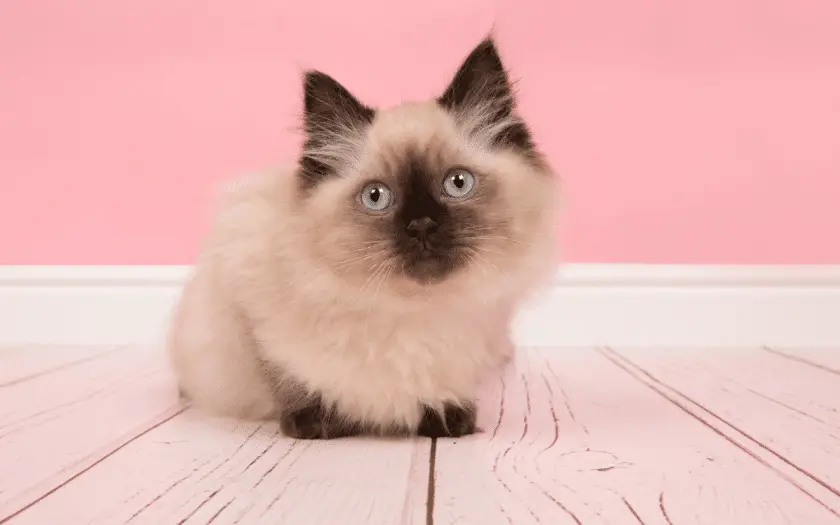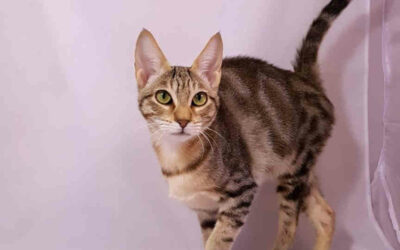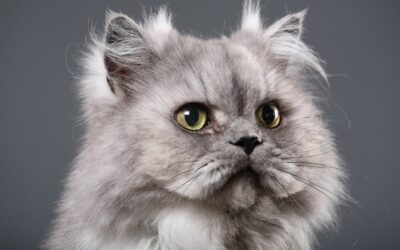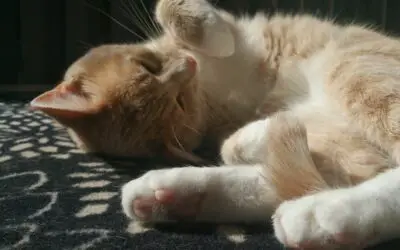The first ragdoll was bred and sold in the early 1960’s, so they are newcomers in the cat world. Yet their stunning appearance and calm temperament have seen them soar in popularity, making them easily one of the most popular cat breeds today.
The name of this breed refers to this cat’s endearing habit of literally ‘flopping’ in your arms when picked up. Although not all ragdolls will do this, their appeal comes from the fact that they are an incredibly affectionate breed that is particularly loving towards their owners.

Appearance & Breed standard
Ragdolls are truly stunning cats, famed for their large oval eyes and dense silky coat. They are one of the larger breeds, with a sturdy & muscular body structure, huge round paws, and a long, bushy tail. Males are often significantly heavier and taller than females.
The official breed standard is blue-eyed with a pointed coat. According to the RFCI (Ragdoll Fanciers Club International), fully grown male can weigh up to 20lbs, with females averaging around 8-12lbs.
Coat
The luxurious fluffy coat of the ragdoll is one of the breeds’ distinct features. They come in a variety of color variations including chocolate, blue, seal, and lilac. Ragdolls are classed as a semi-long-haired breed with an incredibly dense coat, much like a rabbit’s fur. However, unlike other long-haired breeds, they only have a single coat with no undercoat.
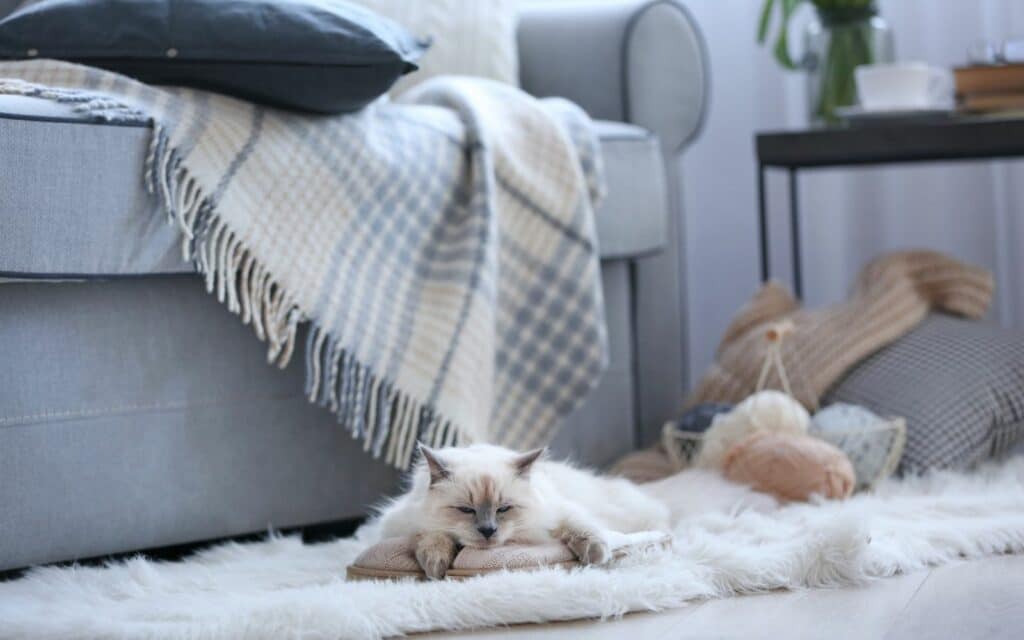
Ragdolls always have pointed coloration on the face, paws, ears, and tail. “Pointed” basically means that they have darker markings on these areas of the body. There is also an unofficial mitted variety of ragdoll, where the chest and paws have white patches.
Eye color
The eyes are perhaps the most striking feature of this breed. All purebreds have gorgeous blue eyes, which is thought to be caused by the gene responsible for point coloration. Some breeders advertise with other eye colors, however, these specimens are likely to be cross-bred.
More breeds:

Behavior
If you are looking for the typical lap-cat that just wants to lap up all your attention, the ragdoll could be the perfect breed for you! They are extremely affectionate and loyal cats, which has earned them the nickname ‘the dog of the cat world’.
Since they adapt very well to indoors, this breed is a great choice for those who live in smaller apartments. They can easily be leash-trained, but as we mentioned, these are not cats that should left outside unattended.
Personality
Ragdolls are incredibly placid and laid-back giants, that seem to live for a good cuddle! Unlike other cat breeds that will shy away from new people and bustling environments, ragdolls are known to actively seek out the company of others.
While they are often described as being docile creatures, that doesn’t mean they’re inactive. In fact, they love to play with toys and get involved in practically any family activity. They are also very intelligent, making them one of the easiest cat breeds to train. Many owners have successfully taught their Ragdoll to perform tricks, including name recall and even fetch!
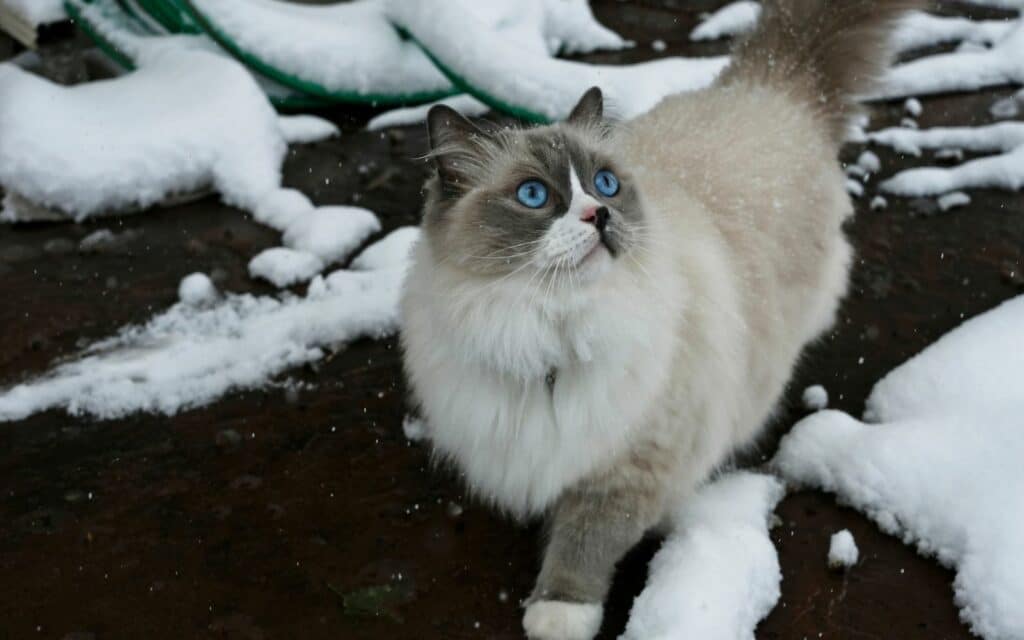
Ragdolls & other pets/children
Ragdolls are very social by nature, and get along well with children and other pets. They are not as territorial as other cat breeds either, which makes them more accepting of strangers. These characteristics make them a popular breed among families, as they are known to be incredibly tolerant of young children.
When things get a little too rough, this cat will generally prefer to distance itself rather than scratch. That being said, the personality of each cat is different, so it is always recommended to you supervise any interactions between your child and a cat.
Grooming
The lack of a thick undercoat makes this breed easier to groom than other long-haired cat breeds, however, they should still be brushed regularly to get rid of any loose hairs. 3 to 4 times a week should be adequate. Luckily, most ragdolls will lap up the extra attention, and grooming is a perfect chance to strengthen the cat-owner bond.
Like most long-haired breeds, ragdolls will shed more in the spring and summer. As a consequence, you will have to brush your feline companion more often in these months. A slicker or bristle brush is the best option for grooming, as these allow you to control the pressure much easier than a stainless-steel comb. Although ragdolls have a lot of fur, they lack an undercoat, so too much pressure can damage the skin and potentially cause pain.

Why you should adopt a ragdoll
Still interested in adopting this lovely breed? Great! Let’s run through the pros and cons of owning one:
Pros
As mentioned above, ragdolls are incredibly laid-back cats that bond quickly with their owners. They also get on well with children, strangers, and other pets. Throw in their gorgeous coat and stunning blue eyes, and it’s not hard to see why this cat has become of the most popular breeds in America!
Cons
The ragdoll’s most endearing quality can also be their biggest disadvantage: they have no concept of privacy. These cats have been known to literally follow their owners into every room of the house, and become very vocal when they don’t get the attention they’re after. Certain people will love this trait, but if you’re one of those people who are not to keen on frequent displays of affection, it can also become a bit too much.
Another thing to consider is that social breeds like ragdolls can struggle when they are left alone. Make sure you have the time to properly care for this cat before deciding to adopt one.
Summary
Ragdolls are beautiful cats both in appearance and temperament. They make wonderful companions for the right owner. If you are looking for a loving feline that you can shower with affection, the Ragdoll could be just the right breed for you! Their relaxed attitude and playful nature make Ragdolls one of the most endearing and delightful pets to have in your life.
Diseases / special considerations
Ragdolls are known to be a relatively healthy breed. However, like most cats, they are at risk of developing certain conditions. This breed in particular is prone to obesity, as they have a tendency to keep eating if food is continually offered. It is therefore best to stick to a strict feeding schedule with this breed and book regular check-ups with your local vet.
Ragdolls can also suffer from Hypertrophic cardiomyopathy, where the blood volume pumped by the heart reduces with each contraction. This condition is caused by a thickening of the heart muscle and is most commonly seen in older males.
Urinary tract infections are another common set of ailments that appear to be prevalent in ragdoll cats.

